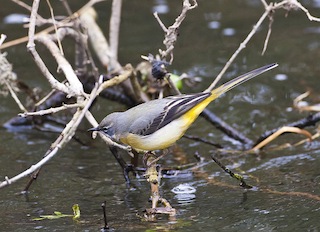 Grey Wagtails are found near upland streams in the summer, but move to lowland habitats in the winter.
Grey Wagtails are found near upland streams in the summer, but move to lowland habitats in the winter.
Photo: Dougy Wright
Scientific name: Motacilla cinerea
Other common names: European Grey Wagtail, Barley Bird
Cornish name: Stenor dowr
Conservation status: Birds of Conservation Concern in the UK, Amber; IUCN Red List, Least Concern
What to look for:
- Colouring and appearance: Long tail, grey-blue upper parts, bright yellow chest and under-tail. In the breeding season, males develop a black throat colouring and white stripes on the face.
- Size: Length 17 to 20 cm, wingspan 26 cm.
- Where: Found across Europe, Asia and northern Africa. Look by mountain streams in the summer, and farmland and urban areas in the winter.
- Call: High-pitched “chic chic chic“
- Similar species: Pied Wagtail, which has black, grey and white colouring; Yellow Wagtail, which has dull yellow upperparts as well as the brighter yellow underneath, and a more obviously black-and-white tail.
 Calling this lovely bird the Grey Wagtail is perhaps a bit of an injustice, given that it is the bright yellow of its chest and tail that is what gets noticed first, and the grey of its back is a distinctive slate colour. In the summer, you are most likely to spot this lively small bird by upland streams and rivers wagging its tail, as its name suggests, as it runs along fast in search of insect food, which it catches from the ground or over shallow water. In the winter they head away from the mountains to farmland and urban areas, in order to avoid the cold: they suffer badly in harsher winters.
Calling this lovely bird the Grey Wagtail is perhaps a bit of an injustice, given that it is the bright yellow of its chest and tail that is what gets noticed first, and the grey of its back is a distinctive slate colour. In the summer, you are most likely to spot this lively small bird by upland streams and rivers wagging its tail, as its name suggests, as it runs along fast in search of insect food, which it catches from the ground or over shallow water. In the winter they head away from the mountains to farmland and urban areas, in order to avoid the cold: they suffer badly in harsher winters.
Why does the Wagtail wag its tail while feeding? It is warning other Wagtails away from its territory: each territory is a stretch of water that may be as long as 1 km. The breeding season stretches for most of the summer, from April to August. Each pair builds a cup-shaped nest in a crevice or on a ledge (sometimes in man-made structures), and share incubation duties for the clutch of three to seven eggs. If the female lays a second clutch of eggs, then the male will continue to care for the fledglings from the first clutch on his own.
The Grey Wagtail’s UK conservation status is Amber because of a continuing long-term decline in the breeding population. According to the annual Breeding Bird Survey, Grey Wagtails have declined by 32% over the last 20 years. This is also true for the Yellow Wagtail (which is Red-listed). The more common Pied Wagtail, whilst it has a green conservation status in the UK, is showing rapid declines along streams and rivers according to the Waterways Breeding Bird Survey.
Did you know…?
…During the breeding season, the males display by flying into the air and then descending slowly, singing continuously.
More information and references:
Svensson, L., Mullarney, K., Zetterstrom, D.,1986. Collins Bird Guide, second edition (translated by Christie, D., Svensson, L.). HarperCollins, London.
Published: September 2014 (updated 2020)
Author: Amanda Scott
Photo: © Natural England/Allan Drewitt
